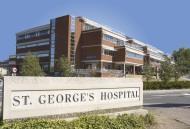FINANCE: St George’s University Hospitals Foundation Trust has seen a steep decline in its finances and is expecting to report a £10m deficit for 2014-15.
This comes two months after Monitor awarded the trust foundation trust status.
The regulator had already delayed the trust’s application in December because of concerns over its finances.

The trust’s March board papers show the financial position has worsened rapidly, and up until December the trust was expecting to deliver a surplus.
The trust is now planning for a deficit up to £30m in 2015-16. A spokeswoman for the trust said this was a “working assumption rather than a firm plan”.
The trust has imposed “very rigorous controls” on spending with immediate effect, including asking managers to cut bank and agency staff spend by 40 per cent.
A spokeswoman for the trust said that staff have been told that if they have any concerns about the cuts affecting patient safety to discuss them with their department leadership team.
Equipment and supplies orders will be “strictly limited”, according to a note to all staff from chief executive Miles Scott.
Support from non-clinical services, including estates, IT and domestic services will be “tightly controlled” and “some service developments and capital expenditure will be delayed”.
Mr Scott said: “Over the winter we have experienced extreme operational pressures resulting in increased costs and also reduced income from planned activity. This has been made worse by national funding changes, for example in education and specialised services.”
St George’s received £2.1m in Project Diamond funding in 2013-14, according to NHS England figures. This funding is given to London trusts to cover the higher costs of specialist work in the capital. However, the fund may not be available to trusts to cover 2014-15.
The March papers show a year to date deficit of £9.5m, which is £14.8m off its year to date target of a £5.3m surplus.
The report said: “This is an adverse movement in [March] of £3.2m.”
The report added that the “worsening” position was due to “under delivery of [service level agreement] inpatient income targets and excess costs of continuing operational pressures” in February.
The note added that the £5.3m surplus plan had been revised downward to a breakeven position in January. However “results for January and February have been significantly worse than we had expected. This in turn has considerably affected our year end forecast. We cannot now reach breakeven and expect to incur a deficit of more than £10m.”
Mr Scott said: “We must turn this around as soon as possible. Many of you will remember the last time that St George’s had a deficit in 2006. Back then it was allowed to get out of control. The impact of the deficit then was to hold St George’s back for nearly a decade while successful foundation trusts in London went from strength to strength. The board is determined not to repeat this history and I know that this is the last thing any of our staff want either.”
Through a freedom of information request HSJ obtained the minutes of a meeting of Monitor’s provider appraisal executive where St George’s application was discussed.
The minutes show that the regulator considered the trust’s financial position to be a “risk”. However, HSJ understands this related to the trust’s working capital position.
The trust recently received a £15m working capital loan from the independent trust financing facility.
Monitor delayed a decision on the trust’s application so it could sort out these borrowing arrangements.
At the time, Miranda Carter, executive director of provider appraisal at Monitor, said: “We are deferring a final decision on whether St George’s should become a foundation trust for a short period whilst it finalises its new funding arrangements.
“When St George’s becomes a foundation trust we want to ensure it is in the strongest possible financial position.”
The executive looked at the “feasibility” of the trust’s projected income growth and whether it would require extra funding to improve its financial position.
It also considered the risk that the trust might find itself in breach of its licence for financial reasons.
The executive concluded: “In light of this discussion the [provider appraisal executive] considered that the trust’s financial position remained an area of risk and that further work should be undertaken to resolve concerns in relation to the trust’s current financial position and the appropriate borrowing arrangements required to ensure that its services would be protected in the event of any financial downturn.”
HSJ asked Monitor what further work was undertaken. However, Monitor was unable to provide a response because of the election purdah period.



























12 Readers' comments